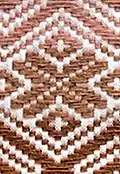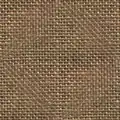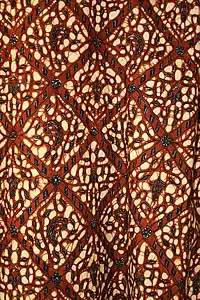Bafta cloth
Bafta (bafta or bafetta) from the Persian bafta meaning woven, is a plain weave textile, it is a kind of calico, originally made in India.[1] It was produced in Bharuch formerly known as Broach, which is a city of Gujarat India. [2] Bafta is a coarse, cheap woven long length but of narrow width material, made chiefly of cotton. Bafta was a generic term for a plain calico of Gujarat especially of Broach and Navsari.
Bafta was one of the middle range dress material during early seventeenth century. Where wealthy women used to wear expensive clothes made of silk, fine cotton and muslin etc., the common women wore clothes made of coarser cotton such as bafta dyed in different colors.[3]The white cotton cloth called baft and the off-white cloth that was called malti or mansuri or kham.[4][5]
Etymology
Although it was produced in India but the name “ bafta ' was derived from Persian word bafta meaning "woven, wrought".[6][7]
History
Broach then (1500–1700) was a major textile manufacturing hub. The Broach city was famous for its bafta in the West and Southeast Asian markets. Bafta was among the leading textile products exported to Europe from Western India for printing in the 18th Century. Production, processing capabilities, and strategic location helped Broach to explore its potential to the fullest. The city is near to the trading major Surat and close to the banks of Narmada.[8][9]
Jean-Baptiste Tavernier (1605–1689), Traveler and French pioneer of trade with India appreciated the ''Broach Baftas'' in his travel tales to India.[10]
In this place are made a great quantity of Baffas, or long and large pieces of cotton. These cottons are very fair, and close woven ; and the price of these pieces is from four to an hundred roupies. You must pay custom at Baroche for all goods that are brought in and carried out.
— Tavernier, Jean-Baptiste., Travels in India
Characteristics and Use
Bafta cloth was a closed plain weave structure. The material was found in many variants, coarse to fine, only cotton and with silk also. it was exported to Europe and the other parts of the world. It was affordable, comfortable material with draping qualities. It was suitable for various dresses.[11] Bafta cloth was priced 5 gold mohars per piece (than) in Akbar's era (1600 AD).[12]
See also
References
- Peck, Amelia (2013). Interwoven Globe: The Worldwide Textile Trade, 1500-1800. Metropolitan Museum of Art. p. 305. ISBN 978-1-58839-496-5.
- Chaturvedi, Archna (2003). Encyclopaedia of Muslim Women: Muslim women and society. p. 158. ISBN 9788171697854.
- Lee, Peter (2014). Sarong Kebaya: Peranakan Fashion in an Interconnected World, 1500–1950. University of Minnesota: Asian Civilisations Museum. p. 75. ISBN 9789810901462.
- Giorgio Riello, Tirthankar Roy (2009). How India Clothed the World. pp. 318, 332. ISBN 9789004176539.
- "Bafta | Definition of Bafta by Oxford Dictionary on Lexico.com also meaning of Bafta". Lexico Dictionaries | English. Retrieved 2020-10-01.
- "bafta – Wiktionary". en.wiktionary.org. Retrieved 2020-10-01.
- Pawar, Appasaheb Ganapatrao; University, Shivaji (1971). Maratha History Seminar, May 28–31, 1970: Papers. Shivaji University.
- Gokhale, Balkrishna Govind (1978). Surat in the seventeenth century.
- "vol1_chapter05". www.columbia.edu. Retrieved 2020-10-01.
- Tavernier, Jean-Baptiste; Phillips, John (1905). Travels in India. Duke University Libraries. Calcutta, "Bangabasi" Office. p. 52.
- Kausar, Zinat (1992). Muslim Women in Medieval India. Janaki Prakashan. p. 63. ISBN 9788185078748.
- دكتور محمد نصر. Fashion And Designing Under The Mughals Akbar To Aurangzeb. A Historical Perspective.



.svg.png.webp)
